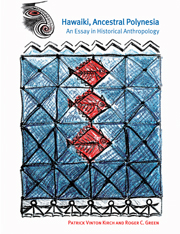Book contents
- Frontmatter
- Contents
- List of figures
- List of tables
- Preface
- List of language abbreviations
- Prologue: on historical anthropology
- Part I The phylogenetic model: theory and method
- Part II Rediscovering Hawaiki
- Introductory remarks
- 4 The Ancestral Polynesian world
- 5 Subsistence
- 6 Food preparation and cuisine
- 7 Material culture
- 8 Social and political organization
- 9 Gods, ancestors, seasons and rituals
- Epilogue: on history, phylogeny, and evolution
- Notes
- Glossary of terms
- References
- Subject Index
- Index of Proto Polynesian Reconstructions
4 - The Ancestral Polynesian world
Published online by Cambridge University Press: 06 January 2010
- Frontmatter
- Contents
- List of figures
- List of tables
- Preface
- List of language abbreviations
- Prologue: on historical anthropology
- Part I The phylogenetic model: theory and method
- Part II Rediscovering Hawaiki
- Introductory remarks
- 4 The Ancestral Polynesian world
- 5 Subsistence
- 6 Food preparation and cuisine
- 7 Material culture
- 8 Social and political organization
- 9 Gods, ancestors, seasons and rituals
- Epilogue: on history, phylogeny, and evolution
- Notes
- Glossary of terms
- References
- Subject Index
- Index of Proto Polynesian Reconstructions
Summary
The lexical reconstructions indicate that the PPN speech community were fishermen-horticulturalists, familiar with a typical tropical Indo-Pacific high island environment and also with certain objects found natively only on certain islands of this category, including the balolo worm, the pearl oyster, such land animals as snakes, pestiferous mosquitoes, bats, owls, rails, pigeons, parrots, and [a] moderately diverse land flora …
pawley and k. green 1971:23The Ancestral Polynesian homeland
Linguistics, archaeology, and comparative ethnography converge to situate the Ancestral Polynesian homeland in space and time: the region known today as Western Polynesia. A Wörter und Sachen approach to locating a proto-homeland, well known to Indo-European specialists (Diebold 1994) is thus unnecessary. Nevertheless, it may be instructive – from a theoretical perspective – to ask whether the classic evidence of “words and things” independently agrees with the conclusions derived from archaeology and linguistic subgrouping. Some years ago, Pawley and K. Green (1971) queried the evidence of PPN lexical reconstructions, to ask where the homeland of the PPN speakers was most likely to have been located. Drawing on a preliminary version of POLLEX (Biggs et al. 1970), they discussed a range of relevant terms, contextualizing these within a set of postulates. For example, their Postulate 4 stated that “the presence in any proto-language of a term denoting a category of objects is taken as indicating that the referents were familiar to the speakers of the language, either as part of their own immediate environment or as part of a nearby environment” (Pawley and K. Green 1971:17).
- Type
- Chapter
- Information
- Hawaiki, Ancestral PolynesiaAn Essay in Historical Anthropology, pp. 99 - 119Publisher: Cambridge University PressPrint publication year: 2001



